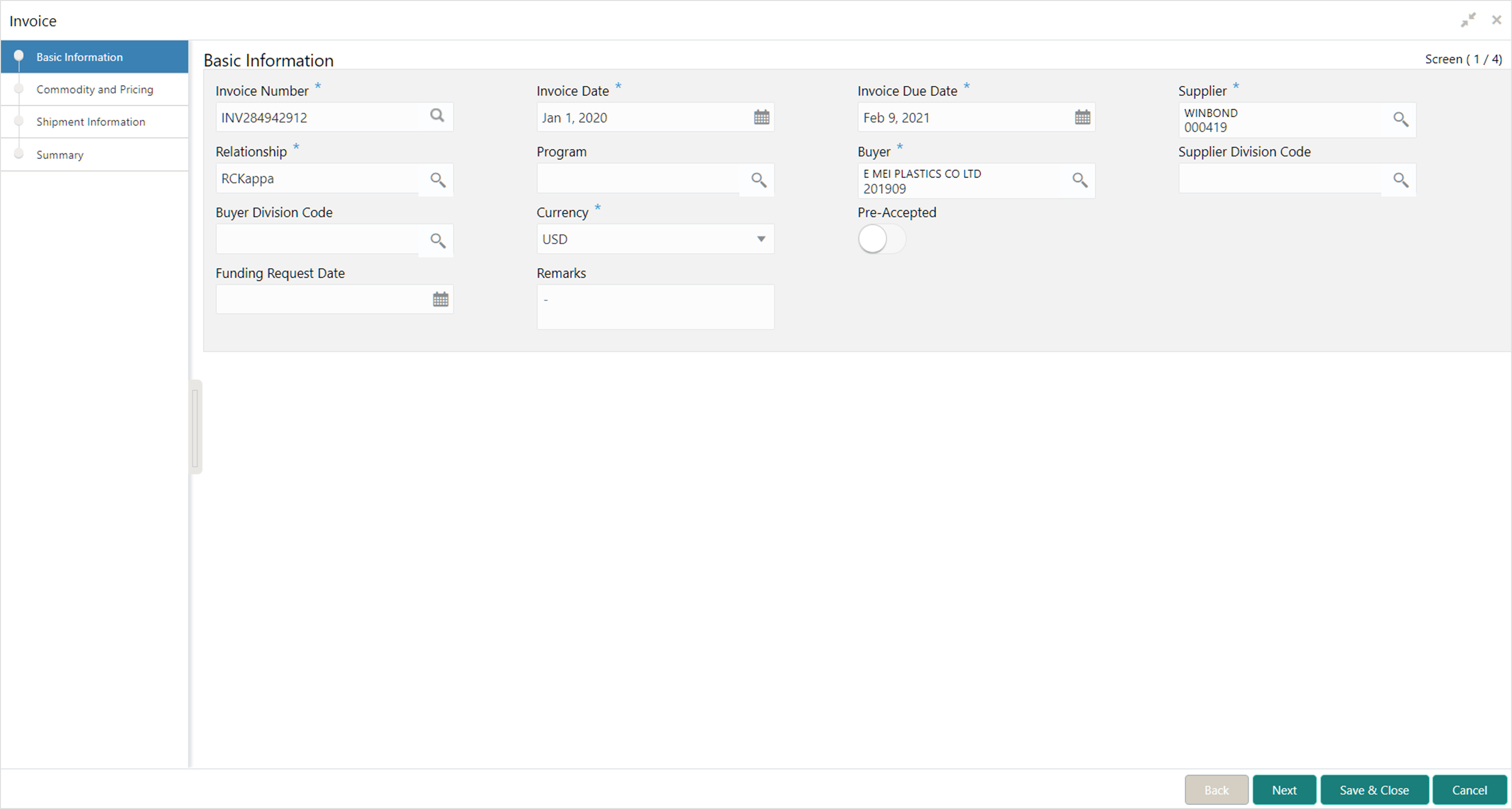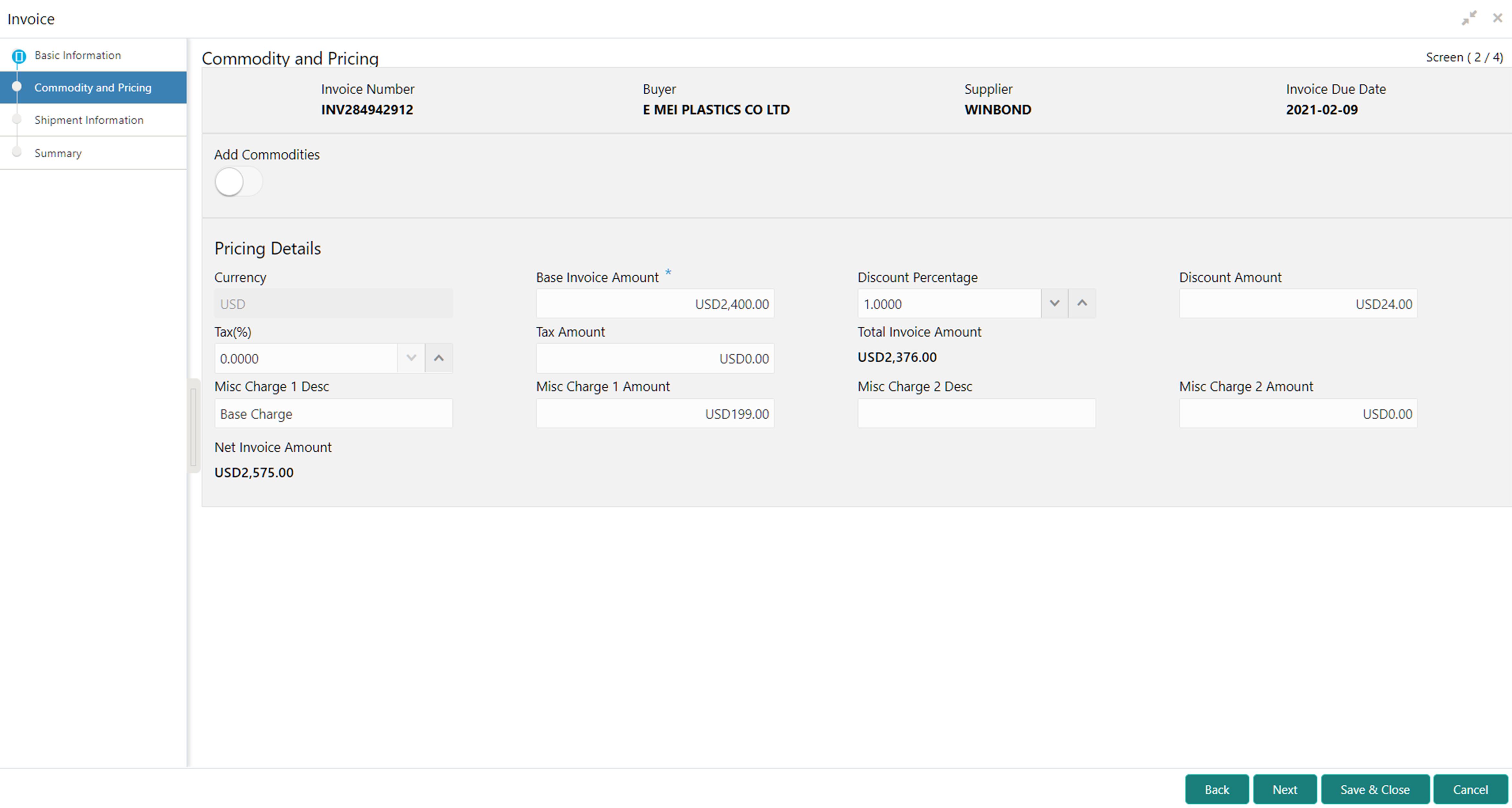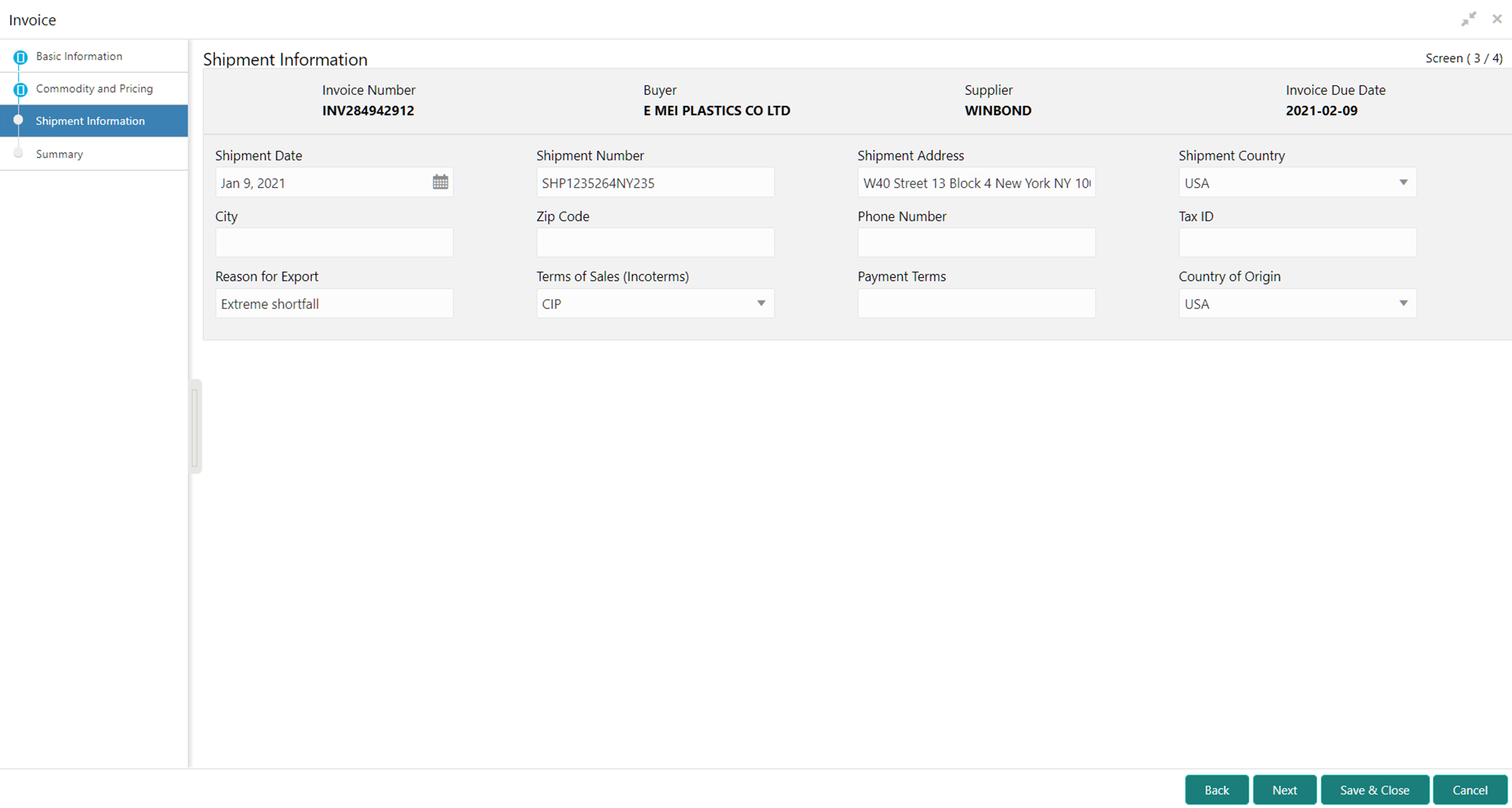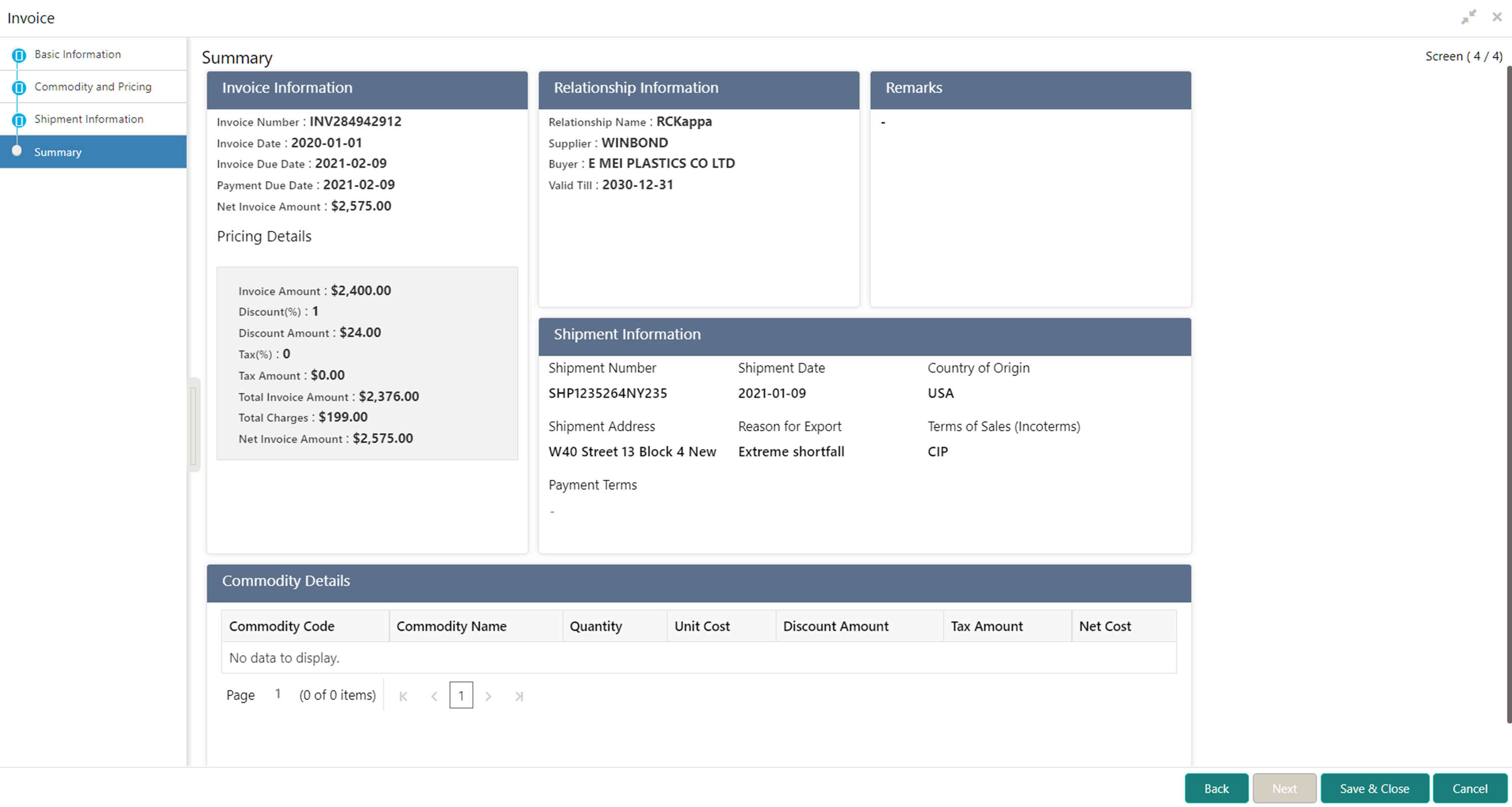3.1 Create Invoice
This topic describes the systematic instruction to create an invoice using Create Receivables and Payables screen.
- On Create Receivables and Payables screen, select Invoice from the Instrument Type list.
Basic Information
- Click Proceed to view the screen for populating the invoice details.The Invoice - Basic Information screen displays.
- Specify the fields on Basic Information screen.For more information on fields, refer to the field description table.
Note:
The fields, which are marked with an asterisk, are mandatory.Table 3-2 Basic Information - Field Description
Field Description Invoice Number Specify the unique reference number for invoice to be created. OR
Click the Search icon to select the existing invoice number.
This field cannot be modified once authorized.
Invoice Date Click the Calendar icon and select the date of invoice creation. By default, the system’s current date is set. Invoice Due Date Click the Calendar icon and select the date by when the invoice is due. Supplier Click the Search icon and select the supplier of the goods/commodity. This field cannot be modified once authorized.
Relationship Click the Search icon and select the relationship of the selected supplier under which this invoice should be created. This field cannot be modified once authorized.
Program Click the Search icon and select the required program under which the invoice should be created. This field is applicable to only OBSCF system.
Buyer Click the Search icon and select the buyer to create the invoice for. This field cannot be modified once authorized.
Supplier Division Code Click the Search icon and select the division code of the supplier. Buyer Division Code Click the Search icon and select the division code of the buyer. Currency Select the currency of the invoice. Pre-Accepted Switch the toggle ON if the invoice is pre-accepted by the buyer. BIC Routing Code Specify the BIC or SWIFT code of the financial institution, to send the payment amount to. Funding Request Date Click the Calendar icon and select the date on which funding for the invoice was requested. Remarks Specify the comments regarding the invoice, if any. Virtual Account Switch the toggle ON, if the repayment account is a virtual one. Repayment Account Number Specify the account number to send the repayment amount to. - Perform any of the below action from the Basic Information screen.
- Click Next to go to the Commodity and Pricing screen.
- Click Save & Close to save the invoice details and submit it for authorization.
- Click Cancel to cancel the creation of the invoice.
Commodity and Pricing
- Click Next on Basic Information tab.The Invoice - Commodity and Pricing screen displays.
Figure 3-3 Invoice - Commodity and Pricing
- Switch the Add Commodities toggle ON to view Commodity Details section.For more information on fields, refer to the field description table.
Note:
The fields, which are marked with an asterisk, are mandatory.Table 3-3 Commodity Details - Field Description
Field Description Invoice Number Displays the reference number of the invoice. Buyer Displays the name of the buyer. Supplier Displays the name of the supplier. Invoice Due Date Displays the date when the invoice is due. Add Commodities Switch this toggle ON to add the commodities being purchased. Commodity Details Displays the fields related to the Commodity details. This section appears if the ‘Add Commodities’ toggle is switched ON.
Commodity Name Displays the commodity name based on the selected commodity code. Unit Select the measuring unit for the goods. Quantity Specify the quantity of the goods as per selected measuring unit. Unit Cost Specify a single unit’s cost of the goods. Discount (%) Specify the percentage of discount to be applied on the total cost. Discount Amount Displays the discount amount based on the discount percentage. Tax (%) Specify the percentage of tax to be applied on total amount post discounting. Tax Amount Displays the tax amount based on tax percentage. Net Cost Displays the net costing based on all the previous fields. - Specify the following details on the Pricing Details section.For more information on fields, refer to the field description table.
Note:
The fields, which are marked with an asterisk, are mandatory.Table 3-4 Pricing Details - Field Description
Field Description Currency Displays the selected currency. Base Invoice Amount Displays the base amount of the invoice. Modify the base invoice amount, if required. Discount Percentage Specify the percentage of discount to be applied on the base invoice amount. Discount percentage is auto-calculated based on entered discount amount. Discount Amount Specify the amount to be discounted from the base invoice amount. Discount amount is auto-calculated based on entered discount percentage. Tax (%) Specify the percentage of tax to be levied on the total invoice amount. Tax percentage is auto-calculated based on entered tax amount. Tax Amount Specify the amount of tax to be levied on the total invoice amount. Tax amount is auto-calculated based on entered tax percentage. Total Invoice Amount Displays the total invoice amount post calculating base invoice amount, discount, and tax. Misc Charge 1 Desc Specify the description of the miscellaneous charges to be added in total invoice amount. Misc Charge 1 Amount Specify the miscellaneous charge amount to be added in total invoice amount. Misc Charge 2 Desc Specify the description of another miscellaneous charges to be added in total invoice amount. Misc Charge 2 Amount Specify the miscellaneous charge amount to be added in total invoice amount. Net Invoice Amount Displays the net invoice amount post adding miscellaneous charges in the total invoice amount. Acceptance Amount Specify the invoice amount that has been accepted by the Buyer. - Click Add icon to add rows in the grid.
- In the Action column of grid, perform any one of the following steps:
- Click Delete icon to remove that specific row.
- Click Edit icon and specify the commodity details in the grid.
- Perform any of the following action from the Commodity and Pricing screen:
- Click Next to go to the Shipment Information screen.
- Click Save & Close to save the invoice details and submit it for authorization.
- Click Back to go to the Basic Information screen.
- Click Cancel to cancel the creation of the invoice.
Shipment Information
- Click Next on Commodity and Pricing tab.The Invoice - Shipment Information screen displays.
- Specify the fields on Shipment Information screen.For more information on fields, refer to the field description table.
Note:
The fields, which are marked with an asterisk, are mandatory.Table 3-5 Shipment Information - Field Description
Field Description Invoice Number Displays the reference number of the invoice. Buyer Displays the name of the buyer. Supplier Displays the name of the supplier. Invoice Due Date Displays the date when the invoice is due. Shipment Date Click the Calendar icon and select the date on which the buyer expects commodity to get dispatched. Shipment Number Specify the unique shipment number to track the shipment. Shipment Address Specify the complete address where shipment should be sent. Shipment Country Select the country to send the shipment to. City Select the city to send the shipment to. Zip Code Specify the postal code to send the shipment to. Phone Number Specify the contact number of the shipment company. Tax Id Specify the unique tax id if shipment charge includes tax amount. Reason for Export Specify the reason for exporting the shipment. Terms of Sale(Incoterms) Select any of the following terms of sales: - DAF – Delivered At Frontier
- DES - Delivered Ex Ship
- DEQ - Delivered Ex Quay
- DDU - Delivered Duty Unpaid
- CIP - Carriage and Insurance Paid To (Insert place of destination)
- CPT - Carriage Paid To (Insert place of destination)
- CIF - Cost, Insurance and Freight
- CFR - Cost and Freight
- FOB - Free On Board
- DDP - Delivered Duty Paid (Insert place of destination).
- FCA - Free Carrier (Insert named place of delivery)
- EXW - Ex Works (Insert place of delivery)
- FAS - Free Alongside Ship (insert name of port of loading)
Payment Terms Specify the terms of payments, if any. Country of Origin Select the country from where the shipment is being sent. - Perform any of the below action from the Shipment Information screen:
- Click Next to go to the Summary screen.
- Click Save & Close to save the invoice details and submit it for authorization.
- Click Back to go to the Commodity and Pricing screen.
- Click Cancel to cancel the creation of the invoice.
Summary
- Click Next on Shipment Information tab.The Invoice - Summary screen displays.
- Review the detail of the invoice being created and perform any of the following action from the Summary screen.
- Click Save & Close to save the invoice details and submit it for authorization.
- Click Back to go to the Shipment Information screen.
- Click Cancel to cancel the creation of the invoice.
Note:
A cashflow record is automatically created for every new invoice record, if the ‘Create Cashflow from Invoice’ system-level configuration parameter is set to ‘Yes’.
Parent topic: Create Receivables and Payables



